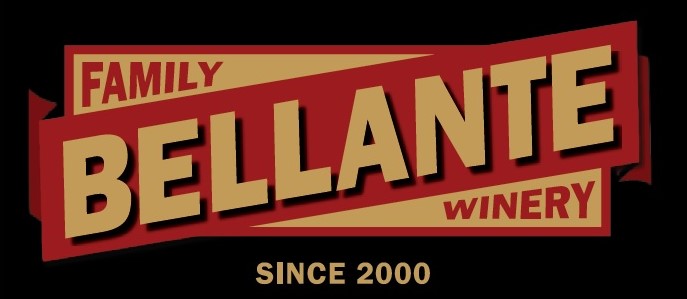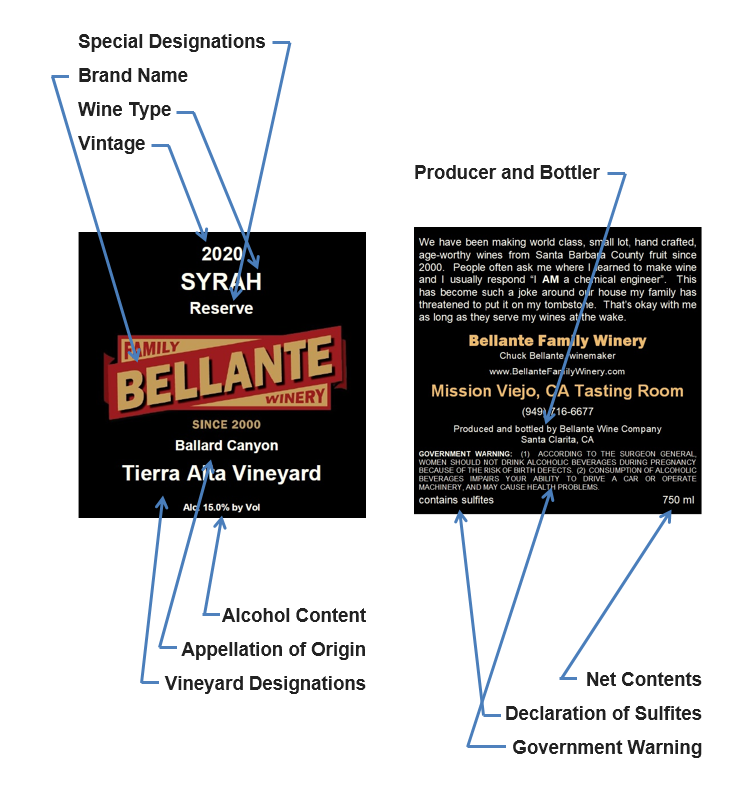
…experience the world class taste of our small lot, hand crafted, age-worthy
Viogniers, Pinot Noirs, and Rhone Reds – made with only the finest Santa Barbara County fruit since 2000…
You can tell a lot about a wine’s quality if you know how to interpret the highly regulated United States wine label. Below we break down the basics.

Brand Name
Mandatory. If no brand name is on the label, the bottler’s name is considered the brand. It is also useful to refer to the bottler’s name if a winery has several brands.
Wine Type
Mandatory. A wine may be labeled by a grape or varietal name, such as Pinot Noir or Syrah, or it may be given a generic name such as “Red Table Wine.” Wines using varietal names must derive at least 75% of their volume from the grape designated, and the varietal name must appear on the label with an appellation of origin.
Appellation of Origin
Wine labels may contain several types of geographic designations of origin:
Appellations of origin that are the names of states and counties can be used on wine labels under federal law if at least 75% of the grapes come from the named state or county. The remainder of the grapes may come from outside the named state or county.
For wine labeled with an American Viticultural Area (“AVA”), which is a specific type of appellation of origin established under federal law, at least 85% of the grapes must come from the named AVA (for example “Santa Maria Valley”), while the remainder of the grapes may come from outside of the AVA. That wine must be fully finished in the state in which the AVA is located.
California law requires that 100% of the grapes come from within California for any wine labeled with the appellation of origin California or a geographical subdivision of the state. This is stricter than the federal labeling standard.
Vintage
Optional. The vintage designates the year in which the grapes were harvested. As of May 2006, federal regulations allow that up to 15% of the blend can be from a vintage other than the stated year. The law was designed to allow American producers to be held to the same standards as other wine producing countries. Previously, the U.S. standard required that 95% of the grapes in the bottle be from the stated vintage. This regulation only applies to wines that do not use an AVA. For example, if the grape source is noted to be “California,” 85% from the stated vintage is the applicable rule. AVA wines are held to a higher standard. For example, for wines labeled Santa Ynez Valley or one of its sub-appellations, 95% of the grapes must be from the stated vintage. The vintage bears no relationship to when the wine was bottled.
Special Designations
Optional. Labels often contain special terms to indicate unusual qualities of the wine. These terms have no legal meaning so let us explain what we mean:
Reserve: We use this designation when our Winemaker rates the wine over 90 points using the Robert Parker Scoring System. Wines rated over 90 points are considered “outstanding” by Mr. Parker.
ma belle Sheri: From the French “ma belle cherie” or “my beautiful darling”; only we’ve changed it to “Sheri”, our matriarch, for her devotion to the winery. This designation is only used on a limited production, Reserve wine.
Figlio e Nuora: “son and daughter-in-law” in Italian; a tribute to our son and his wife. This designation is used on limited production, non-Reserve wines.
Vineyard Designations
Optional. Many wineries name the vineyard where the grapes were grown because the winery believes the property produces an unusually high-quality grape, yielding a distinctive wine. Almost all our wines are single-vineyard. When using a vineyard designation on a wine label, federal regulations require that 95% of the grapes be grown in the named vineyard. In addition, most high-quality grape growers require samples be submitted for taste testing before the Vineyard Name can be used on the label. This helps insure the high quality standards single-vineyard wines are associated with.
Producer and Bottler
Mandatory. This part of the label gives a great deal of information about the production of the wine. The label must indicate the bottler and its location. Several descriptions are common:
“Produced and bottled by” certifies that the bottler fermented 75% or more of the wine at the stated address . In combination with other information on the label, such as a vineyard designation, this term provides the consumer with significant information about the origin of the wine and who is responsible for its production.
“Cellared and bottled by” indicates that the bottler has subjected the wine to cellar treatment before bottling at the stated address.
“Made and bottled by” indicates that the bottler fermented at least 75% of the wine at the stated address.
“Bottled by” indicates that the winery bottled the wine at the stated address, which may have been grown, crushed, fermented, finished, and aged by someone else at some other address.
Estate Bottled
Optional. This term certifies legally that the winery grew 100% of the grapes on land it owns or controls and that the winery crushed, fermented, finished, aged, and bottled the wine in a continuous process on the same property. Both the vineyard and winery must be located in the viticultural area that is stated on the label.
Alcohol Content
Mandatory. This statement on a wine label indicates the alcohol content by volume, with a tolerance of plus or minus 1.5% if the wine has an alcohol content of 16% or less and a tolerance of plus or minus 1.0% if the wine has an alcohol content of more than 16%. However, the tolerance cannot be used to cross the 16% alcohol content threshold, which is the dividing line between two tax classes. Finally, a wine that is 16% or less alcohol by volume can be labeled “table wine” without any notation of the numeric alcohol content.
Net Contents
Mandatory. The fluid volume in metric measurement must be indicated on the label or be blown into the glass.
Declaration of Sulfites
Mandatory. Wines which have a level of 10 parts per million or greater of sulfur dioxide must be labeled with a sulfite declaration (“Contains Sulfites”).
Government Warning
Mandatory. All wine bottled after November 18, 1989 must bear the health warning statement in the exact manner and wording specified in the federal regulations.